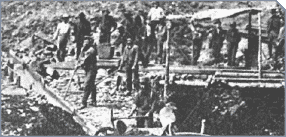The South Dakota Gold Rush


The South Dakota Gold Rush |
|
| The Black Hills gold rush originally began in late July 1874 when the 7th Calvary searched the Black Hills area for a location to establish an army post. The gold was found on some land that was set aside for Indians. Some miners were still sneaking in even after they were told to stay out of the Indian territory. Military forces tried to hold back the tide of gold-fevered prospectors, escorting them out of the Sioux treaty lands, but it was like emptying a wash tub with a teaspoon. | |
| By the Fall of 1875 there were an estimated 500 miners in the Black Hills. The gold rush started a conflict between the United States and the Great Sioux Nation. In late August 1875, prospectors from Montana had located deposits of gold of gold paying twenty to forty cents to the pan. |
|
| On June 15, 1876 the Battle of the Little Bighorn between the 7th Calvary and the Lakota Nation with their allies Cheyenne and Arapahos at Greasy Gras, Montana took place. Sitting Bull and his 4,000 warriors were encamped when Custer and his troops came upon them. Hopelessly outnumbered 200 of Custer's troops were killed in less than twenty minutes. | |
| By July of 1876, a million dollars of gold at $20 an ounce had been taken from the Black Hills. By this time approximately 10,000 people populated the Hills. During the summer of 1876 $500,000in gold was shipped out of the gulch in massive iron safes in the treasure coaches. Armored coaches were put on the line in 1878, often transporting as much as $200,000 in a single shipment. An 1877 shipment worth $350,000 weighed in at more than 1,000 pounds. More than 7,000 miners arrived and left the Black Hills during the year of 1876 when the total gold production amounted to about $1,500,000. | |
|
|
The treaty of 1868 ceded land for the Great Sioux Reservation. The gold miners didn't really care that they were taking gold from the land that the Indians owned. In the spring of 1875 the federal government attempted to solve the problem of ownership of the Hills by inviting American Indian leaders to Washington D.C. |
| From 1876 to 1890 when the railroad was being built in Deadwood, gold was shipped out of the Hills on stage coaches, attractive targets for road agents. From the earliest diggings near Custer, the gold seekers migrated north to Hill City and Palmer` Gulch, Harney, Hayward, and Keystone, Rockerville and on to Deadwood gulch. The railroad seemed to be the fastest and best rout to the gold mines in the Black Hills. There was a lot of gold taken from the Black Hills during these years. | |
| Sources: | |
| http://www.deadwoodmagazine.com/archives/goldbuilt.htm | |
| http://www.goldoutlet.com/history.html | |
| http://www.nps.gov/wica/history_of_the_black_hills.htm | |
| http://www.americanparks.net/deadwood_history.htm | |
| http://freepages.history.rootsweb.com/~gtusa/usa/sd/deadwood.htm | |
| http://www.legendsofamerica.com/sd-deadwood2.html | |
| Jacob Crow | |
| 8th American History | |
| 2005 project | |